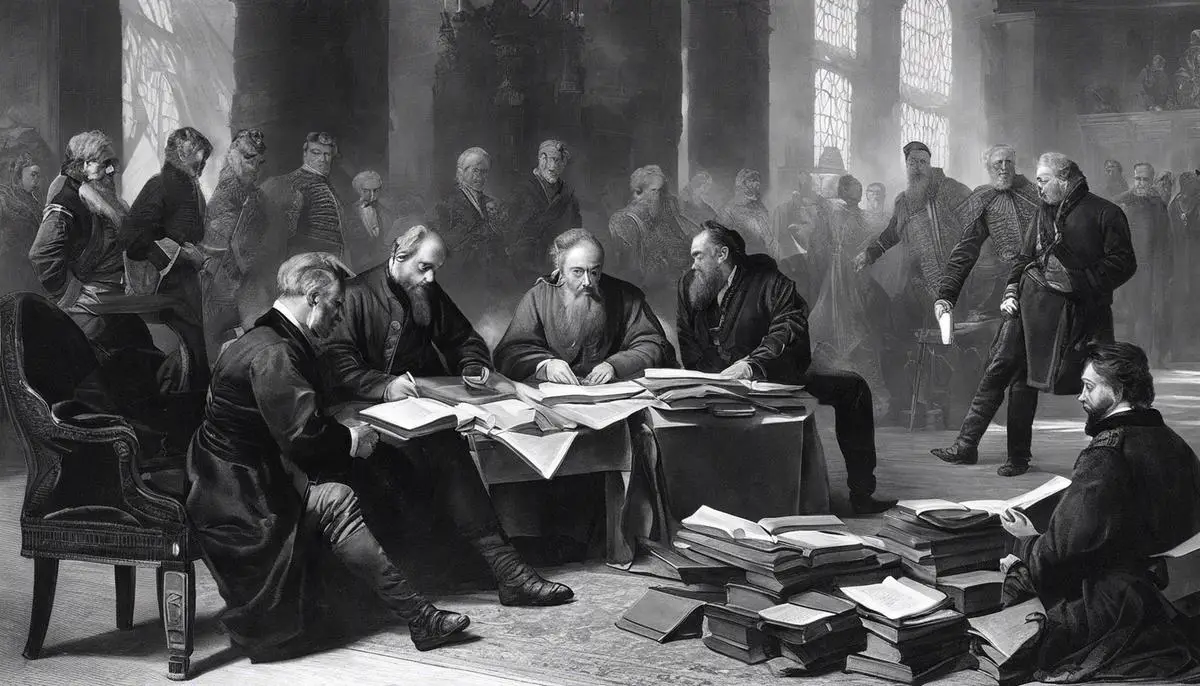As we delve into the multifaceted world of hegemony, a prevalent force shaping political, economic, and societal structures, it is essential to dissect its roots, implications, applications, and possible future evolutions. This exploration serves as a compass for enthusiasts and hobbyists seeking to master the art of class leadership, particularly with the revolutionary game – Hegemony: Lead Your Class to Victory (2023). By examining the major schools of thought—from Gramsci to Laclau—and their unique perspectives, we begin an intellectual journey towards deepening our comprehension of this much-debated phenomenon. Practical applications of hegemony in the context of class leadership will be investigated, as well as its global perceptions and how they may be tactically utilized to achieve victory.
The Theoretical Perspectives of Hegemony
Title: An Examination of The Major Theories Underpinning Hegemony
Hegemony, a term often associated with the works of Italian scholar and political theorist Antonio Gramsci, is an intricate concept that elucidates how dominant groups or entities maintain and exert their power, and it plays an ubiquitous role within social, political, and economic paradigms. Given its relevance, understanding the essence of hegemony requires an examination of the major theoretical frameworks that underpin this concept. Three major theories, namely Marxian, Gramscian, and Neo-Gramscian, stand at the forefront of such discussion.
Marxian Hegemony Theory arises from the works of Karl Marx and Friedrich Engels. It suggests that the ruling class, typically associated with capital or wealth, maintains power by instilling their cultural and social norms onto the dominated classes, subtly coercing them into accepting and abiding by these norms. This assertion often manifests in economic relationships, as the wealthier class shapes the perceptions of value, functionality, or desire through its control over resources and production mechanisms.
Then, there’s the Gramscian Theory of Hegemony, espoused by Antonio Gramsci. In contrast to the Marxian perspective, Gramsci posits that power doesn’t solely rest on coercion or imposition but rather on consent. Power, according to Gramsci, is an outcome of both hegemonic ideals and institutions that are voluntarily accepted by the populace. This approach puts a notable emphasis on ideological and cultural institutions like education and media, recognizing their roles in shaping perceptions and realities.
Lastly, there’s the Neo-Gramscian Theory of Hegemony, championed by Robert W. Cox. This perspective extends Gramsci’s insights to international settings, exploring the concept of hegemony in global political economy. Essentially, neo-Gramscians argue that power stems from global social relationships and transcends territorial boundaries, breaking the premise of national confines. Consequently, hegemony is viewed as an interlocking system of economic, political, and socio-cultural structures that shape collective consent to the global order.
So, as the exploration of hegemony persists in the academic sphere, it might do well to remember that the tapestry of power is woven from threads of cultural norms, consent, and global interdependence. These theories – Marxian, Gramscian, and Neo-Gramscian – act as lenses to ponder on this intriguing confluence of power dynamics, offering a holistic understanding of hegemony in its subtle, yet profound manifestations.

Application of Hegemony in Class Leadership
Harnessing Hegemony: Noteworthy Applications in Class Leadership
Exploring the realm of hegemony presents fascinating insights on the power dynamics within various societal and economic structures, offering a profound comprehension of how cultural, ideological, and political dominance is cultivated and perpetuated within these settings. Building upon the foundations laid by the erudite intellectual discourse from Marx, Gramsci, and the Neo-Gramscian scholars, there emerges a marked realization of how class leadership can be guided by these hegemonic principles, elucidating the complex interplay of social norms, consent, and global interconnectedness in the framework of leadership dynamics.
A crucial application of hegemony in class leadership takes root from the explorations of the French sociologist Pierre Bourdieu, who expanded on Gramsci’s theorization by introducing the concept of habitus. The habitus encapsulates the set of social norms, practices, and expectations internalized by individuals through socialization processes. Leadership, in this context, employs habitus to strategically guide the conduct, decision-making, and perceptions of subordinates, thereby aligning behaviors with the status quo and perpetuating hegemonic norms.
Moreover, societal structures heavily influence how leadership roles emerge within class settings, shaped by the complex machinations of symbolic power. Through cultural capital, ideological orientations, and the representation of certain orthodox viewpoints as ‘natural’ or ‘normal’, leaders can leverage the notion of symbolic power to legitimatize their authority, ensuring less resistance and greater compliance within the class. A manifestation of this can be observed in pedagogical settings where teachers use curricula that subtly endorse the dominant ideologies, reinforcing a form of educational hegemony.
The manifestation of hegemony in class leadership extends significantly beyond domestic or localized settings, as reflected in the Neo-Gramscian analysis. The global interconnectedness of cultural, economic, and political structures provides the framework for the emergence of transnational class leadership, which, by navigating through global socio-cultural norms and gaining consent transcending borders, wields hegemonic influence on an international scale.
Furthermore, such global leadership dynamics often propagate the rise of a global civil society, engaging with and influencing international organizations, political structures, and policy frameworks, subtly shaping global consensus. Thus, a class leader with profound understanding of these hegemonic principles can effectively utilize them to navigate power dynamics, build alliances, and exert influence on a global scale.
In essence, the hegemonic principles derived from Marxian, Gramscian, and Neo-Gramscian discourse offer a robust framework for deciphering class leadership dynamics. From Bourdieu’s concept of habitus to the power of symbolic representation and the potential for transnational class leadership, it is clear that the intriguing facets of hegemony are rich with guiding principles for strategic and effective class leadership. By understanding these principles, leaders can cultivate cultural consent, align with dominant norms, and utilize the complexity of global interconnectedness to propagate their authority and influence. The beauty of this whole process lies in the fact that these leaders are not solely dictating, but rather, molding the flock in coordination with prevailing aspirations and ideologies, thereby making the process seamless and less resistant. Quietly, yet decisively, the wheels of hegemony turn, driving the rhythms of leadership and power throughout society’s grand tapestry.

Global Perception and Implications of Hegemony
With a substantial understanding of several theories of hegemony, we now turn our focus to how said theories affect class leadership, particularly on a seemingly enormous scale such as the global stage. It becomes increasingly pivotal to inspect these implications, due to the ever-increasing globalization of our societies.
By analyzing Marxian, Gramscian, and Neo-Gramscian theories of hegemony, we encounter an intricate panorama of societal vibrations, where both visible and invisible power structures intricately waltz to the rhythm of global events. The complex weave of these influences is not merely theoretical but extends deeply into the pragmatic sphere. We witness this in particular when we observe trends in class leadership on the global stage.
A significant implication is that class leadership, within the perceptions of global hegemony, is anything but random. Instead, it is systems and structures – often invisible and unspoken – that determine who rises to these esteemed positions. This prompts a deeper reflection on the concept of ‘habitus’. Derived from the extensive works of Pierre Bourdieu, ‘habitus’ refers to the embodied dispositions that characterize the way individuals perceive, react to, and interact with the social world around them. It carries immense weight in structuring social hierarchies, thus, is a powerful determinant of class leadership.
Further, the manifestation of power cannot be discussed without mentioning ‘symbolic power.’ This form of power, which manipulates symbols to establish and maintain supremacy, holds impact over behavior and decisions relating to class leadership. It speaks to the conscious and subconscious acceptance or reinforcement of social hierarchies, ultimately governing attitudes towards placement and acceptance of class leaders.
Moving in tandem with the subliminal wielding of symbolic power is educational hegemony, a powerful tool used to disseminate and solidify dominant ideologies. By carefully tailoring curriculum, those who hold power imprint their values and perspectives onto the next generation, indirectly moulding future leaders. Competently crafted educational hegemony can support in the creation and continuance of class leaders who comprehend, validate, and reinforce existing power dynamics.
Transnational class leadership also comes into play in our interconnected world. As leaders navigate the differing socio-cultural norms of numerous nations, they must also comprehend and consider global hegemonies. The understanding and manipulation of these cultural norms and structures provide them an edge in the pursuit of their agendas, revealing a symbiotic relationship between hegemony comprehension and leadership success.
The rise of a global civil society is another crucial factor. International organizations and global policy frameworks have rapidly evolved and grown in number, prompting class leaders worldwide to predict and respond to their impact. This shift towards internationalization has resulted in a principal convergence of hegemonic structures at a world level, further complicating power dynamics and reshaping class leadership.
In conclusion, our understanding of hegemony – based on decades of scholarly research – offers valuable insights into the intricacies of class leadership within our increasingly global society. The nuanced interplay between cultural norms, ideologies, symbolic power, and educational systems guide the rise and fall of global class leaders. Henceforth, those who can discern and maneuver these complex channels are the ones who are poised to lead effectively in our interconnected world.

Conceptualizing Hegemony in the 2023 Context
As we gaze ahead to 2023, a vision of the future materializes that is both intriguing and influential, particularly within the context of hegemony. It paints a vibrant image of progression, advancement, and transformation. It is a canvas upon which the evolution of class leadership is starkly depicted, reflecting the changing dynamics of power, dominance, and influence.
The forthcoming period dynamically molds the understanding and application of hegemony within class leadership. New-age technologies, the proliferation of artificial intelligence, the changing dynamics of global politics, and the transformation in social norms and cultural values together stir a potent concoction that can potentially reshape the contours of hegemonic theory and its interrelation with class-based leadership.
No longer static and bound within classical texts, the concept of hegemony, as it pertains to class leadership, is subject to this swift societal transformation. The adoption of technology and artificial intelligence, for instance, is forming a new code of understanding. Class leadership is increasingly dependent on digital dominance and cyber consent. In order to maintain their hegemony, class leaders must now comprehend, adapt, and exploit these emergent technological elements.
An increasing emphasis is being placed on the sustainable development goals, environmental protection, and the realities of climate change. This environmental consciousness reshapes the multiple layers of hegemony. Class leadership now pivots around a new “green” axis of power, acquired not just by economic control, but through establishing environmental stewardship.
Immigration, the displacement of people, and a more multicultural and diverse society inevitably alter the indigenous norms and values that have traditionally dictated hegemony. Adaptation becomes a critical leadership skill in this evolving landscape, and those with the ability to navigate and glide through multicultural intersections can be truly effective leaders. Thus, class leadership of 2023 reflects a multiplicity of voices in shaping hegemonic norms, a genuine departure from the monolithic structures of the past.
The Internet has emerged as a significant player in reshaping the hegemonic landscape. Organizations are increasingly global and virtual: they transcend boundaries, cultures, laws, and languages. Power dynamics are influenced more by online presence, reach, and influence than physical or conventional authority. The online realm complicates the traditional hegemonic dynamics, giving rise to leaders who can successfully navigate this intricate labyrinth of digital dominance.
Educational systems too, influenced by the changing landscape, impact the hegemonic structures of leadership. Class divisions are no longer solely determined by simplistic factors; they now extend to reflect digital literacy, access to resources, and multimedia competence.
As we watch 2023 unfold, this fanciful portrait of hegemony and class leadership acquires increasingly richer hues. However, a persistent and vital challenge remains – maintaining the balance of power. The shifting dynamics of power can widen the chasm between leaders and the led, creating an unbridgeable gap threatening the fundamental essence of a harmonious society.
In conclusion, hegemony within class leadership through 2023 becomes an amalgamation of traditional norms interpolated with new-age trends. The task ahead is no mere navigation through these evolving avenues but steering the helm toward a more inclusive, equitable and dynamic leadership that is firmly rooted in the mutual consent and well-being of all stakeholders.

Embracing a forward-thinking attitude, the discourse has ventured into future speculation about the impact of societal norms, technological advancements, and geo-political shifts expected in 2023 on the concept and applications of hegemony in class leadership. The evolution of hegemony is a continuous one, with many variables and uncertainties. However, with due insight and understanding, individuals can equip themselves to adapt and implement hegemonic strategies effectively in their endeavor to lead in the immersive virtual world of Hegemony: Lead Your Class to Victory (2023). It is the understanding and navigation of these nuanced layers of hegemony that will mark the difference between mere participation and ultimate victory in the game.
